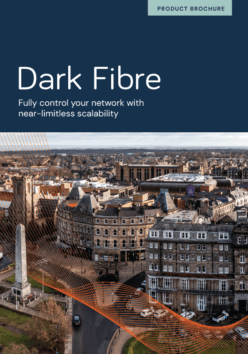MPLS vs Dark Fibre
MPLS can offer robust and reliable connectivity, yet Dark Fibre offers a level of network future-proofing that other means of connectivity can’t. Here we discuss the pros and cons of both.
Build your Dark Fibre network nationwide
Total control, near limitless capacity
MPLS vs Dark Fibre
MPLS can offer robust and reliable connectivity, yet Dark Fibre offers a level of network future-proofing that other means of connectivity can’t. Here we discuss the pros and cons of both.
What is Multi-Protocol Label Switching (MPLS)
Multi-Protocol Label Switching (MPLS) is a type of connectivity that is well known for ensuring reliable connectivity for real-time applications and Quality of Service (QoS) to keep critical business information flowing. High-availability MPLS offers support for services such as VoIP, virtual desktops, video conferencing and cloud applications and guarantees no loss of quality.
What are the benefits of using MPLS?
MPLS has been around for a while and has several benefits. For a start MPLS, as the name suggests, is protocol agnostic and can handle any-to-any connectivity which provides flexibility. MPLS was designed before Cloud Computing and would mostly have been used to connect branch offices to HQs – meaning it can scale to multiple sites – but in today’s environment there are easier, more cost-effective ways to connect to the Cloud.
That said, MPLS does provide a level of security as it is a Virtual Private Network and so enables a business to side-step using the Public Internet – protecting sensitive data that you would not want to fall in to the wrong hands. Having a VPN style network also guarantees better performance and scalability.
Are there any downfalls to using MPLS?
However, the robustness of MPLS is also its downfall. Whereby MPLS offers a solid, reliable network and can deliver guaranteed performance, MPLS requires pre-determined A and B points, and once the circuits are up and running, it is difficult to make changes easily. Where previously bandwidth could be quite costly, eroding prices means that MPLS networks are now becoming more appealing for lower-bandwidth users who are unlikely to need to massively scale up and make changes.
It is here that Dark Fibre has a big difference. Dark Fibre is essentially future-proof. As well as bespoke routing, Dark Fibre easily enables bandwidth to be scaled up or down depending on business needs and will enable to support the business as it grows. With a fixed cost, Dark Fibre can actually be a more cost-effective choice than MPLS if you require high capacity services.
The important thing to note with Dark Fibre vs MPLS is that Dark Fibre is an unlit, unmanaged connection. There are no associated SLAs and the business who leases or purchases the fibre is responsible to the equipment used to light the fibre and for the ongoing maintenance. An advantage here is a business can select their own vendors and can take advantage of technologies like Dense Wavelength Division Multiplexing (DWDM) whereby the spectrum can be split up in to the various wavelengths to increase capacity across the fibre. Find out more about Dark Fibre and DWDM here.
A newer alternative to MPLS is SD-WAN, a new technology which also ensures reliable connections and real-time information. Also protocol-agnostic it enables users to control the network from a central location. It offers the ability to have greater visibility and flexibility across the entire estate.
What is the typical bandwidth of MPLS?
While some MPLS networks on T1 lines are limited to 1.5 Mbps service, networks with higher capacity can provide significantly improved services: from 10Mbps to 10Gbps. MPLS bandwidth upgrades can be costly, but MPLS does offer scalability, as well solid bandwidth utilisation and reduced network congestion. Since it is a virtual private network, MPLS also gives businesses security.
Offering near limitless capacity, Dark Fibre networks are essentially futureproof. As networks following routes you specify and manage, they also provide flexibility and control.








